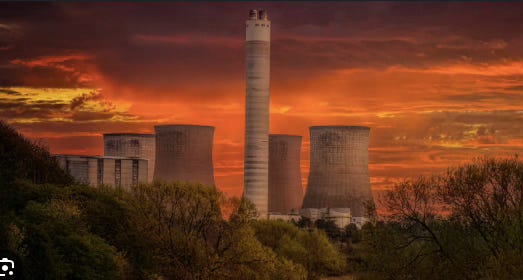Westminster's arrogance, aggression, ignorance and folly
Scotland should be fierce in its response
This letter was published as the leader in The Herald letters page on May 20th, 2024. I asked Frances McKie, the author, if I could re-publish it here, and she agreed. The UK has used Scotland as its nuclear waste dump for over 70 years. Much of our beautiful land and seacoast has been contaminated with toxic radiation from depleted uranium shells, the Sellafield reprocessing plant that spews poison along our west coast, rotting nuclear submarine hulks at Rosyth and in the Clyde and toxic leaks from the Dounreay, Torness, Chapelcross, Hunterston A and B nuclear power plants. Our cancer rates are the highest in the UK. And now Alistair Jack wants to impose more nuclear power onto Scotland against our will. Will this issue finally galvanise Scots to break out of this toxic union prison?
Within and around Alister Jack’s beautiful, ”remote and sparsely populated” parliamentary constituency, there are several appalling examples of the consequences when arrogance, aggression, deliberate ignorance and outright folly are combined with the lethal hazards of nuclear radiation.
At Chapelcross, the main concern is the long-term contamination of land and groundwater by Tritium, discharged over 4 decades by the nuclear reactors there, both deliberately and accidentally. At Dundrennan, thousands of depleted uranium shells have been fired into the Solway Firth and abandoned. In the 1980s, Americium 241 from Sellafield in Cumbria, was found in the River Cree. This radioactive contamination of the Solway Firth and Scotland’s coasts from the most dangerous nuclear site in Europe has continued for the last 40 years.
In 1976, the Westminster Government accepted the Flowers Report recommendation that no more nuclear reactors should be commissioned until a safe and reliable method of storing nuclear waste was established. Therefore, as part of Westminster’s desperate rush to try nuclear again, with a cynical nod to scientific credibility, the bed of the Solway Firth, already carrying that cocktail of nuclear discharges from Sellafield, has been subjected to seismic blasting. And Westminster will surely confirm, very soon, geology, tides, currents, wildlife and international treaties not withstanding, that it is safe to dump - out of sight and out of mind - all the Highly Radioactive Waste from the leaking tanks at Sellafield.
But there is no safe method of containing nuclear waste. There is no reliable material to resist the corrosive effects of radiation. This has been known for over 50 years and has been demonstrated yet again, most powerfully in France, where in 2022 stress related corrosion caused over 12 reactors to be shut down at the same time.
In April this year, the German Government finally shut down all nuclear reactors; there will be no further experiments with nuclear power in one of the most technically advanced nations in the world. Their reasons included the fact that no safe method of waste disposal had been established and the consequences of nuclear accidents like Fukushima and Chernobyl are too devastating to risk further mistakes. Germany is now leading the world on the development and storage of alternative energy sources. We might have hoped that Westminster would heed their example.
In their current, bankrupt and panicked state, however, confronted with the poisonous consequences of privatised vital services like transport, energy and water, Westminster parties - Labour and Tory - are lurching from one monstrous mistake to another. The “Great British Nuclear” folly, Hinkley Point C, is already over 6 years behind schedule, already 3 times over budget and if it follows the pattern of its only counterpart in Flamanville in France, it will be shut down for repairs and replacements of vital parts within months of trials beginning. UK taxpayers will be footing the bill for decades to come.
50 years ago, Westminster chose beautiful Galloway as the UK High Level Nuclear Waste Dump on the grounds that it was “remote and sparsely populated” with communities who were unsophisticated and unlikely to protest effectively. That arrogance, aggression, deliberate ignorance - and outright folly - was answered by a fierce and devastatingly effective political campaign involving the whole of Scotland, which cornered the incoming Secretary State for Scotland, George Younger, MP for Ayr, with nowhere to hide.
Mr. Jack’s remarks to the House of Lords Select Committee this week, an ugly reminder of how Westminster regards Scotland, should be answered just as fiercely and effectively.
And I hope Galloway leads the way.
Frances McKie
Additional sources:
http://news.bbc.co.uk/2/hi/uk_news/scotland/458877.stm
https://www.no2nuclearpower.org.uk/radwaste/history-of-nuclear-waste-disposal-proposals-in-britain/
https://theferret.scot/nuclear-submarines-dump-scotland/
At the 1986 Dounreay Inquiry, a Wigtownshire group-Radioactive Pollution Survey for Wigtownshire (RPSW) submitted the results of a survey of radioactive pollution, commissioned by them from Dr. Robert Wheaton at Edinburgh University. The survey included alpha emissions and Americium 241, a decay product of plutonium, was identified in the River Cree. Our Orkney group commissioned the same surveys for Orkney and Caithness. UKAEA were very angry. They did not like anyone looking for alpha or beta and getting independent results.
https://www.telegraph.co.uk/business/2024/05/16/top-labour-donor-joins-campaign-stop-hinkley/#:~:text=Millionaire%20Labour%20donor%20Dale%20Vince,biggest%20nuclear%20power%20station%20project.






I was at several of the meetings in D&G during the attempt to dump their nuclear waste there. If I remember rightly, this was their second attempt at dumping in D&G. It appeared to be the female partners of the farmers who gave the loudest and most successful battle cry. It also has to be noted that because of the proven uncertainty in geological stability, burying was ruled out (rejection of NIREX's case by Sec. State Environment 1997, following inquiry). I thought that the logical conclusion from the inquiry was, above ground storage, for constant monitoring and inspection, and to utilise existing nuclear sites, in use or in decommissioning mode.